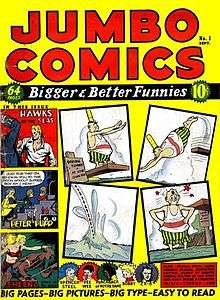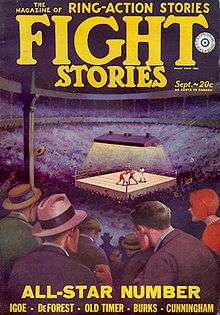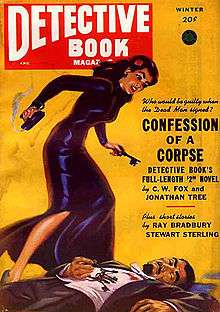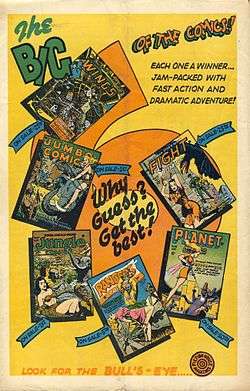Fiction House
|
House ad for "The Big 6 of the Comics!" advises, "Look for the Bull's-Eye..... Fiction House Magazines". | |
| Industry | Publishing |
|---|---|
| Genre | Aviation, detective, jungle, sports, Western |
| Founded | 1920s |
| Defunct | 1950s |
| Headquarters | New York City |
Key people | Thurman T. Scott |
| Products |
Comic books Pulp magazines |
Fiction House is an American publisher of pulp magazines and comic books that existed from the 1920s to the 1950s. Its comics division was best known for its pinup-style good girl art, as epitomized by the company's most popular character, Sheena, Queen of the Jungle.
History
Pulp fiction



Fiction House began in 1921[1] as a pulp-magazine publisher of primarily aviation, Western and sports pulps.[2] It occasionally acquired other publishers' magazines, such as its 1929 acquisition of Frontier Stories from Doubleday, Doran & Co.[3] By the end of the year, a New York Times article referred to John B. Kelly as "head" of Fiction House, Inc., located at 271 Madison Avenue.[4]
By the 1930s, the company had expended into detective mysteries.[2] In late 1932, however, in the midst of the Great Depression, Fiction House cancelled all 12 of its pulp magazines — Aces, Action Stories, Action Novels, Air Stories, Detective Book, Detective Classics, Fight Stories, Frontier Stories, Lariat, Love Romances, North-West Stories and Wings — with the stated hope of eventually reviving them. At this time, John W. Glenister was president of Fiction House and his son-in-law, Thurman T. Scott, was secretary of the corporation.[1]
Comic books
By the late 1930s, Scott, now publisher,[5] expanded Fiction House into comic books, an emerging medium began to seem a viable adjunct to the fading pulps. Receptive to a sales call by Eisner & Iger, one of the prominent "packagers" of that time who produced complete comic books on demand for publishers looking to enter the field, Scott released Jumbo Comics #1 (Sept. 1938).[5]
Fiction House star Sheena, Queen of the Jungle appeared in that initial issue. Will Eisner and S.M. "Jerry" Iger had created the leggy, leopard-wearing jungle goddess for the British magazine Wags,[6] under the joint pseudonym "W. Morgan Thomas".[7]
Fiction House's other features in that initial foray included the period adventure "Hawks of the Seas" (continuing a story from Quality Comics' Feature Funnies #12, after Eisner-Iger and Quality had had a falling out), and several now-obscure strips ("Peter Pupp"; "ZX-5 Spies in Action"; "Spencer Steel"; "Inspector Dayton").[8] These include three by future industry legend Jack Kirby, representing his first comic-book work following his debut in Wild Boy Magazine:[9] the science fiction feature The Diary of Dr. Hayward (under the pseudonym "Curt Davis"), the modern-West crimefighter strip Wilton of the West (as "Fred Sande"), and Part One of the swashbuckling serialization of Alexandre Dumas, père's The Count of Monte Cristo (as "Jack Curtiss"), each four pages long.
Jumbo proved a hit, and Fiction House would go on to publish Jungle Comics; the aviation-themed Wings Comics; the science fiction title Planet Comics; Rangers Comics; and Fight Comics during the early 1940s — most of these series taking their titles and themes from the Fiction House pulps. Fiction House referred to these titles in its regular house ads as "The Big Six," but the company also published several other titles, among them the Western-themed Indians and Firehair, jungle titles Sheena, Queen of the Jungle and Wambi, and five issues of Eisner's The Spirit.[10]
Quickly developing its own staff under editor Joe Cunningham followed by Jack Burden,[11] Fiction House employed either in-house or on a freelance basis such artists as Meskin, Matt Baker (the first prominent African-American artist in comics), Nick Cardy, George Evans, Bob Powell, and the British Lee Elias, as well as such rare female comics artists as Ruth Atkinson, Fran Hopper, Lily Renée, and Marcia Snyder.
In January 1950, the Manhattan-based company signed a lease for office space at 130 W. 42nd Street.[12]
Feminist comics historian Trina Robbins, wrote that
...most of [Fiction House's] pulp-style action stories either starred or featured strong, beautiful, competent heroines. They were war nurses, aviatrixes, girl detectives, counterspies, and animal skin-clad jungle queens, and they were in command. Guns blazing, daggers unsheathed, sword in hand, they leaped across the pages, ready to take on any villain. And they did not need rescuing.[13]
Despite such pre-feminist pedigree, Fiction House found itself targeted in psychiatrist Dr. Fredric Wertham's book Seduction of the Innocent (1954), which in part blamed comic books for an increase in juvenile delinquency. Aside from the ostensible effects of gory horror in comic books, Wertham cast blame on the sexy, pneumatic heroines of Fiction House, Fox Comics and other companies. A subsequent, wide-ranging investigation by the Senate Subcommittee on Juvenile Delinquency, coupled with outcry by parents, a downturn in comics sales, the demise of the pulps, and the rise of television and paperback novels competing for readers and leisure time, Fiction House faced an increasingly difficult business environment, and soon closed shop.
List of Fiction House pulps
Source for below 12 titles, unless otherwise noted:[1]
- Aces
- Action Novels
- Action Stories (225 issues, September 1921 - Fall 1950)
- Air Stories
- Detective Book Magazine
- Detective Classics
- Fight Stories (47 issues, June 1928 – May 1932; 59 issues, Spring 1936 - Spring 1952)
- Frontier Stories
- Lariat
- Love Romances
- North-West Stories
- Planet Stories (71 issues, Dec. 1939 - June 1955)[14]
- Wings
- All Adventure Action Novels
- All-American Football Magazine
- Baseball Stories
- Basketball Stories
- Black Aces
- Bull's-Eye Detective
- Bull's-Eye Sports
- Bull's-Eye Western Stories
- Civil War Stories
- Football Action
- Football Illustrated Annual
- Football Stories
- Frontier Stories of the Pioneer Days
- George Bruce's Aces (Glen-Kel)
- George Bruce's Air Novels
- Jungle Stories
- North-West Romances
- Soldier Stories
- True Adventures
- Two Complete Detective Books (Real Adventure)
- Two Western Books
- Two Western Romances
List of Fiction House comic books
- Cowgirl Romances
- Fight Comics
- Firehair
- Ghost
- Indians
- Jumbo Comics
- Jungle Comics
- Ka'a'nga, Jungle King
- Man O'Mars
- Movie Comics
- Planet Comics
- Rangers Comics
- Sheena, Queen of the Jungle
- The Spirit (five issues, 1952–54)
- Wambi
- Wings Comics
References
| Wikimedia Commons has media related to Fiction House. |
- 1 2 3 "12 'Pulp' Magazines Stop Publication". The New York Times. December 28, 1932. p. 19. Retrieved February 4, 2015.
...in the eleven-year history of Fiction House.
- 1 2 Johnson, Virginia E. (Summer 2004). "Detective Book Magazine". Web Mystery Magazine. 2 (1). Archived from the original on July 17, 2011.
- ↑ "Frontier Stories Magazine Sold". The New York Times. March 25, 1929. p. 12. Retrieved February 4, 2015.
- ↑ "Air Tales Stolen, 'War Ace' Is Held". The New York Times. December 12, 1929. p. 27. Retrieved February 4, 2015.
- 1 2 Goldstein, Andrew (n.d.). "Fiction House: History and Influences". Connecticut Historical Society. Archived from the original on September 8, 2008.
- ↑ Sheena, Queen of the Jungle at Don Markstein's Toonopedia. Archived from the original November 10, 2011
- ↑ Schumacher, Michael (2010). Will Eisner: A Dreamer's Life in Comics. Bloomsbury USA. p. 39. ISBN 1-60819-013-7.
- ↑ Jumbo Comics at the Grand Comics Database
- ↑ Per Kirby's recollection in interview, The Nostalgia Journal #30 (Nov. 1976), reprinted in The Comics Journal Library, Volume One: Jack Kirby (2002) ISBN 1-56097-466-4, p. 3
- ↑ Fiction House at the Grand Comics Database
- ↑ Cassell, Dewey, with Aaron Sultan and Mike Gartland. The Art of George Tuska (TwoMorrows Publishing, 2005), ISBN 1-893905-40-3; ISBN 978-1-893905-40-5, p. 30
- ↑ "Added Space Taken by General Foods". The New York Times. January 24, 1950. p. 45. Retrieved February 4, 2015.
...Fiction House Inc., Universal Buying Service, in 130 W 42d St...
- ↑ Robbins, Trina (1996). The Great Women Superheroes. Kitchen Sink Press. p. 86. ISBN 0-87816-481-2.
- ↑ Thomas D. Clareson, "Planet Stories", in Tymn & Ashley, Science Fiction, Fantasy and Weird Fiction Magazines, pp. 476–481.
Further reading
- Comic Book Marketplace vol. 2, #57 (March 1998): "Fiction House Pulps!" by Christian K. Berger, pp. 34–37, 44
- Comic Book Marketplace vol. 2 2, #60 (June 1998): "Fiction House Sci-Fi" (cover gallery) pp. 40–43
- Comic Book Marketplace vol. 2, #72 Oct. 1999): Letter from Bill Black on Australian versions of Fiction House comics, pp. 8–9
- Fiction House: A Golden Age Index compiled by Henry Steele (San Francisco, A. Dellinges, 1978)
- Fiction House: A Golden Age Index of Planet Comics (San Francisco: A. Dellinges, 1978)
- Ron Goulart's Comics History Magazine #4 (Summer 1997): "The History of Good Girl Art", Part 2, pp. 3–5
- Scott, Kevin Michael (1991). Images of women in the popular culture publications of Fiction House, 1941–1952 (MA thesis). Iowa State University. Retrieved February 14, 2013.
External links
- Good Girl Art at AC Comics.com
- Reading Room Index to the Comic Art Collection, Michigan State University Libraries Special Collections
- Galactic Central
